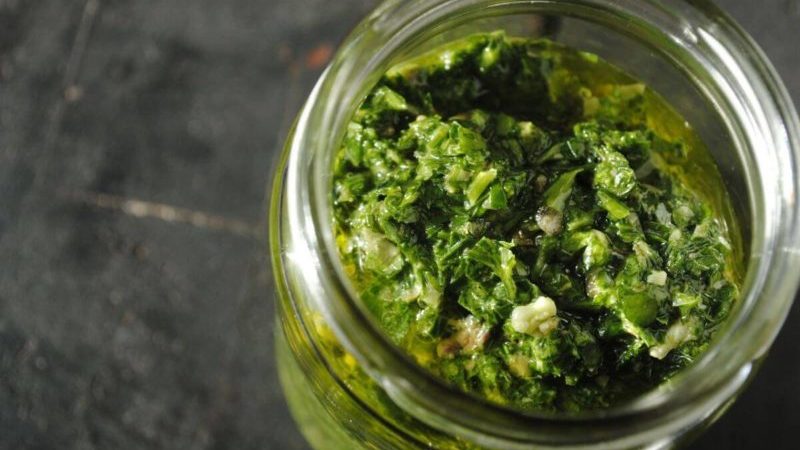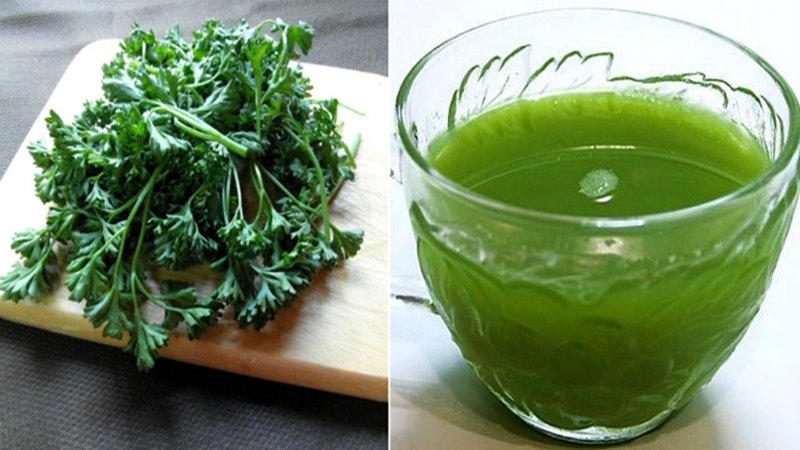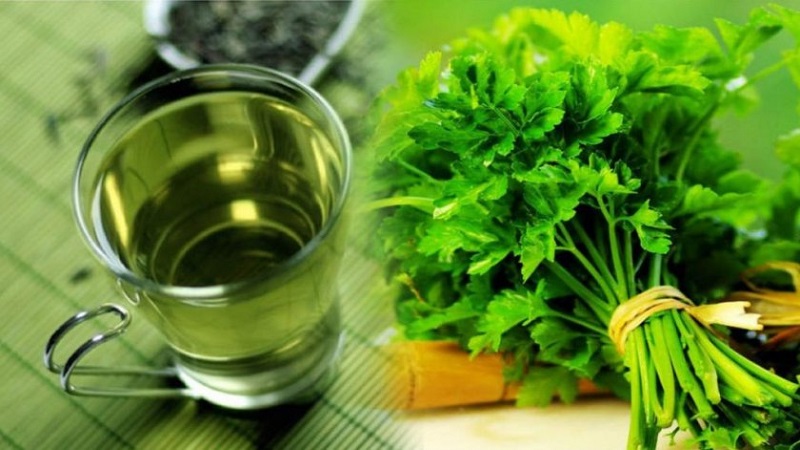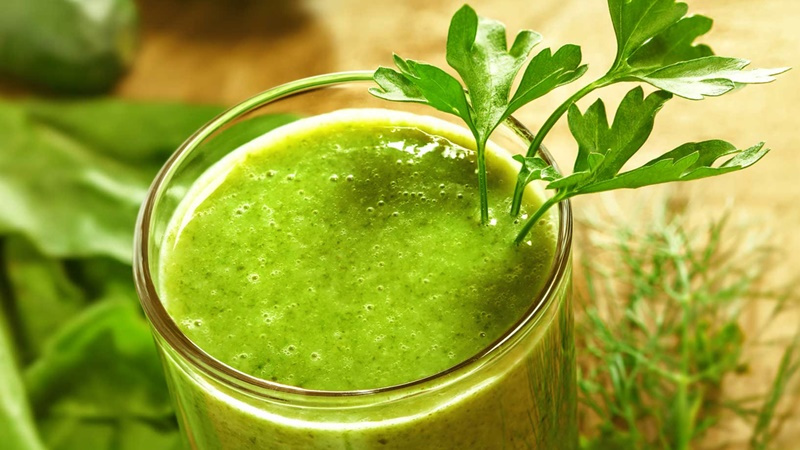Useful properties of parsley broth and how to cook it correctly
Parsley is one of the most popular seasonings for salads, main dishes and canned food. However, the plant is also widely used for health, medical and cosmetic purposes.
The article will tell you about the benefits, dangers and uses of the decoction and other drinks from this plant. You will learn how to properly brew parsley and how many days and in what quantity to drink tea from this plant for therapeutic purposes.
The content of the article
Useful properties of parsley broth

All parts of parsley have a pleasant spicy flavor due to the content of essential oils based on apiol (parsley camphor). Its concentration in the fresh bunch is 0.01-0.3%, in the roots - up to 0.08%.
Parsley is rich in vitamins A, C, K, B1, B2, PP, E, as well as elements: calcium, magnesium, phosphorus, iron, potassium, silicon, fluorine, zinc.
Important. Vitamin C in this herb is five times more than in lemon. A small bunch contains the daily rate of mineral salts of potassium, magnesium and phosphorus.
The benefits of parsley decoction:
- improves digestion, painful bloating;
- promotes faster healing of cystitis, inflammation of the urethra, urolithiasis;
- improves skin color and texture;
- it is used for any inflammation of the skin;
- whitens teeth and strengthens the gums;
- has a beneficial effect on vision;
- relieves swelling, relieves cramps;
- strengthens blood vessels, heart muscle;
- has a positive effect on the endocrine system;
- increases the level of hemoglobin;
- used in the treatment of gynecological diseases;
- relieves itching from insect bites;
- used as an antifungal, anti-inflammatory and antibacterial agent for abscesses and bruises;
- has expectorant properties;
- lowers sugar levels, useful in diabetes;
- enhances immunity.
All these properties are fully preserved and properly prepared broth.
For women
Parsley helps women stay beautiful and healthy, strengthening the body from the inside and out.
With parsley:
- whiten the skin from sunburn, fight freckles;
- eliminate acne;
- treat gynecological diseases;
- relieve pain during menstruation;
- normalize the endocrine system by taking the infusion on an empty stomach.
Parsley is useful for menopause, as it relieves the condition during ebb and flow.
The composition of the plant contributes to the normalization of the reproductive system, therefore its decoctions and fresh herbs are useful when planning pregnancy.
However, when pregnancy occurs, the presence of parsley in the diet should be treated with caution. In addition to the positive effect - a decrease in swelling, an increase in hemoglobin levels - it can also bring harm. So, for example, a plant, and especially drinks from seeds or roots, can induce a rush of blood to the uterus and thus provoke a miscarriage or early labor.
For men

Parsley is a useful plant for normalizing hormonal levels in the male body. It also regulates production of sex hormones... Herbal medicinal drinks normalize prostate tone, prevent the appearance of BPH, increase libido and improve sperm quality.
The plant helps with alcohol or nicotine poisoning.
In the case of early baldness, men are advised to use parsley-based hair strengthening masks.
For kids
Teas and infusions of parsley strengthen children's immunity. The plant increases concentration, improves memory, and carotene improves visual acuity.
The anti-inflammatory properties of the infusion will help maintain the cleanliness and health of children's teeth, and fluoride and calcium will help to strengthen the enamel.
Important. Infusions of parsley can be given to children only when they reach the age of 10-12 months.
What are parsley decoctions, infusions and tea used for?
In Russia, the plant was called "petrosilova grass" and was used as a medicine. The juice of the grass was used to smear skin inflammations, insect bites, and the persistent smell of parsley scared away mice and ants.
Infusions, decoctions and teas are made from both fresh and dried herbs, in advance preparing it for the winter.
Important! It is not recommended to harvest parsley for the winter, sprinkling it with salt. There is an opinion that with this method of harvesting in the plant substances are formed that can cause the growth of tumors, including malignant ones.
Store ready-made infusions in the refrigerator for no more than 3-4 days. Alcohol tinctures are stored for up to a year.
Slimming
Cleansing the body of toxins and removing edema is the main purpose of using a decoction for losing weight... During diets, the plant supplies the body under stress with vitamins and nutrients.
In folk medicine

Broths and infusions of parsley have not found serious use in traditional medicine, but the plant is widely known as a folk remedy for the treatment of skin diseases, gastrointestinal tract.
With the help of parsley, they eliminate bad breath, and are used for inflammatory processes of the gums, tongue or oral mucosa. Parsley can also eliminate the smell of garlic and onions.
Cotton swabs dipped in parsley juice and applied to the eyes for 10 minutes will relieve fatigue after prolonged reading.
Fresh parsley pounded into gruel or chewed is used as an anesthetic for insect bites and bruises. Also, bites can be lubricated with parsley juice - this will speed up their healing.
For skin beauty
The ability of parsley to restore the beauty of the skin has been known for a long time: parsley was added to water for washing, the stems and seeds were used to cleanse the teeth, and the frozen broth was used to whiten and make the skin fresh.
What is parsley broth, infusion and tea made of?
All parts of the plant are used to prepare healthy drinks from parsley, however, each part has its own characteristics in processing and brewing. Parsley is widely used in food both fresh in summer and mainly dried in winter.
From the roots
Chopped parsley roots (2 tsp) pour 1 tbsp. water and simmer in a "water bath" for about 10 minutes. Then they are removed from the heat, insisted for at least an hour and filtered. It is taken in accordance with the course of treatment.
From the stems
A tablespoon of chopped plant stems is poured with 250 ml of water and boiled over low heat for 1-3 minutes. The container is tightly closed with a lid and insisted for 30 minutes, after which the liquid is filtered. It is recommended to take 2-3 tbsp. l. decoction three times a day before meals.
From the leaves
Two teaspoons of chopped fresh herbs are poured over 1 tbsp. water, bring to a boil and simmer in a "water bath" for about 30 minutes, then filter and cool.
From seed
For the preparation of the broth 2-4 tsp. plant seeds are poured with 1 tbsp. (200-250 g) of water, bring to a boil, turn off and let it brew for half an hour to an hour. The finished broth is filtered and consumed in accordance with the instructions of the doctor.
How to brew and drink the broth correctly

Parsley drinks in general bring undoubted benefits to the body.But if the broth is used to combat a disease, it should be exclusively an accompanying agent and not replace the main therapy.
When treating with parsley broths, it is recommended to supplement the diet with nuts and dried fruits, since abundant urination washes out useful minerals from the body.
With diseases of the gastrointestinal tract (GIT)
To improve digestion 0.5 tsp. crushed parsley seeds are poured with 2 tbsp. cold boiled water and insist in a tightly closed container.
Reception course: 1 tbsp. l. 3-4 times a day half an hour before meals.
With cystitis
A teaspoon of crushed parsley seeds is poured into 1 liter of cold boiled water and left to infuse overnight, and then filtered.
Reception course: 3 tbsp. l. infusion every 2-3 hours.
For the treatment of cystitis with increased diuretic effect 800 g of parsley is poured with milk so that it covers all the greens, put on low heat or in a non-hot oven until the milk has evaporated. At the same time, it should not be allowed to boil. Then the mass is squeezed through cheesecloth and filtered.
Reception course: 1 tbsp. l. every hour.
As a diuretic
To enhance urination 2-4 tsp. Pour 0.5 liters of unpasteurized milk into finely chopped parsley roots, put on a small fire and heat to half the volume. The finished broth is filtered.
Fresh broth should be prepared daily.
Reception course: 1-2 st. l. decoction in the morning and evening.
To lower cholesterol levels
In 1.5 liters of boiling water put 1 kg of washed and sliced lemons and three bunches of finely chopped parsley. The container is tightly closed with a lid, cooled to room temperature and placed in a refrigerator.
The course of administration: 100 g daily on an empty stomach, and the drink should be shaken very well before each use.
With menstruation
To restore and normalize the menstrual cycle 4 tbsp. l. dried seeds are poured into 1 tbsp. boiling water, bring to a boil, remove from heat, leave for 30-40 minutes and filter.
Reception course: 2 tbsp. l. decoction to take every 2-3 hours.
For painful periods, you can add beetroot juice to parsley juice.
Slimming
A bunch of fresh herbs is finely chopped, put in boiling water (0.5 l) and boiled for 5-10 minutes. The cooled broth is filtered and stored in the refrigerator.
The course of administration: 250 ml of the finished broth daily.
It is also possible to prepare an infusion: pour parsley with boiling water and insist (without boiling). This infusion is useful for losing weight and relieving puffiness.
For facial skin
Parsley is a source of health and youth for the skin - of course, when used correctly.
Regular use
In order to give the skin of the face freshness and healthy whiteness, fresh greens are crushed, placed in a jar, poured with boiling water, tightly closed and left to cool completely. The resulting infusion is filtered, poured into ice molds and frozen.
Course of admission: in the morning after each washing, wipe the skin dried with a towel with an ice cube.
Fight against individual imperfections
For whitening freckles, 30-40 g of greens is poured into 1 tbsp. boiling water and insist for an hour. The resulting strong broth is filtered and mixed with 0.5-1 lemon juice. Wipe your face 1-2 times daily.
For an anti-wrinkle remedy, 50 g of parsley is poured into 0.5 liters of water, boiled for 15-20 minutes, cooled, filtered and poured into ice molds. Every morning and evening, rub the washed and towel-dried face with an ice cube.
As an "ambulance" for edema of the eyelids: 1 tbsp. l. greens pour 1 tbsp. boiling water, cool and filter. The course of admission: apply gauze or cotton wool abundantly moistened with infusion to the skin of the eyelids for 10-15 minutes.
If the skin is oily, chopped parsley is mixed with curdled milk and applied to the face for 20 minutes, then washed off with cool water.
For normal and dry skin, greens are mixed with sour cream, applied to the skin for 20-30 minutes, washed off with cold water without soap.
To refresh the skin color, chopped greens are mixed with cottage cheese in a 1: 1 ratio and applied to the face for 15-30 minutes, washed off with cool water.
Dark circles under the eyes and swelling are removed with a mask of crushed leaves and stems of the plant, mixed with 2 tsp. sour cream. The resulting mixture is applied to problem areas for half an hour, after which it is washed off with cold water. You can use a suitable cream.
For hair
Parsley has been successfully used as a health product for hair and scalp.
To make the hair healthier and shinier, 50 g of parsley is poured into 0.5 l of water, boiled for 15-20 minutes, cooled, filtered and rinsed with the resulting broth after each wash.
To give colored hair a natural shade and elasticity, two large plant roots are poured into 1 liter of water, boiled for 15-20 minutes, cooled and filtered. Apply immediately after painting or curling.
To strengthen hair 1 tsp. crushed seeds are mixed with 1 tsp. alcohol and 2 tsp. castor oil. The resulting mass is rubbed into the scalp for a month every other day (that is, 15 times), after which the hair is allowed to rest for at least 1-2 months.
Possible harm and contraindications

Despite the enormous benefits that parsley brings to the body, remember that the use of any herbal remedies must be controlled and not exceed the concentration established by the recipes, as well as the daily intake.
Parsley juice is concentrated, so it is used only in highly diluted form and no more than 1 tbsp. l. appointment.
Eating more than 10 grams of parsley per day can be harmful, even poisoning. Drinking too much can lead to headaches and muscle aches, nausea, and decreased appetite.
The use of the plant is strictly prohibited when:
- exacerbations of any chronic diseases;
- during pregnancy and lactation;
- with an acute form of cystitis and nephritis;
- with pancreatitis;
- with gout;
- with epilepsy;
- for many diseases of the genitourinary system - the plant has a pronounced diuretic effect;
- with allergies.
Conclusion
Parsley is an affordable and widespread herb with a rich composition. It is also successfully used for medicinal purposes - for problems with the gastrointestinal tract, endocrine diseases, in cosmetology - to improve the health of the skin and hair, to combat skin defects, and also as an anesthetic. And also parsley is one of the most favorite culinary spices, retaining its beneficial properties both fresh and dry.